Agronutritional strategy against heat stress

It is well known that adverse environmental conditions on a crop have a decisive influence on its development, growth and productivity. They are part of the so-called abiotic stress and this is caused by water deficit, excess salinity, cold, heat, excess light irradiation, etc.
In the face of excessively high temperatures, generally accompanied by low relative humidity in the hot periods of the year, they subject crops to hydric stress and with it, the decrease in profitability of their crops.
In addition, in the case of fruit trees, unlike vegetables, their cultivation lasts for years and this stress can even compromise future crop cycles.
Glybet: Strategy using agricultural biostimulants against abiotic stress
In this article we will refer to the Glybet product, which is found within the catalog of agronutrient and biostimulant products for plants developed by JISA. This is an efficient tool that it makes available to the farmer, to include in his agronutritional strategy against the abiotic stress of his crops.
This biostimulant with an osmoprotective effect is formulated from natural Glycine betaine and compounds that favor its assimilation, with proven results to combat these stress effects on plants.
Glycine betaine used by JISA in its formulation Glybet is chemically speaking a quaternary amine. It is a non-ionic compound that plants synthesize as an adaptive response to situations of water deficit, producing an osmoprotective effect at the cellular level.

The consequences derived from the application of Glybet are, in the first place, energy savings, since the plant does not have to synthesize this Glycine betaine. Secondly, it guarantees a faster plant response to stress caused by lack of water, extreme temperatures, excessive light irradiation and salinity.
As direct bypass in the plant:
- This more efficient reaction rate will be seen in a greater ability to carry out photosynthesis.
- It guarantees a better performance of all the biochemical processes that occur at the cellular level.
- Better development and quality of pollen in times of adverse environmental conditions.
- An improvement in the absorption of nutrients because the plant can have its stomata open for longer without fear of dehydration, favoring the entry of nutrients into the plant, improving the production and quality of the fruits treated with Glybet.
Osmoprotective effect of Glybet on plants
Returning to the osmoprotective effect, … What is it? Any plant, when subjected to water stress, sets in motion a series of responses to protect itself from dehydration.
At the cellular level, when the amount of water in the medium decreases, there is a flow of water from the cytoplasm to the outside of the membrane, producing a loss of turgor in the tissues and a decrease in the photosynthetic rate of the cell.
The plant begins to synthesize substances that compensate the concentration of solutes in the cytoplasm with that in the external environment and prevent excessive outflow of water from the cells.
How to apply Glybet with osmoprotective effect?
This product can be applied both in irrigation and by foliar spraying.
Both forms are equally valid, although the JISA technical team recommends, depending on the crops and their states, alternating them as far as possible.
Let us remember that foliar nutrition is a very useful tool at specific times of crops.

Dose and crops on which to apply Glybet against heat stress
Naturally, advising on which crops a certain product can be applied, as well as its dosage, is complicated because it depends on determining factors such as the species, its phenological state, age, cultivation technique, its nutritional state, etc.
But, to provide some data, always for guidance and in the absence of the field technician’s opinion, it can be said that the agronomic benefits we are talking about are used for any crop, whether fruit, horticultural or ornamental.
It should also be noted that the results will be greater as soon as we have crops that are more sensitive to stress and more adverse conditions that may affect them.
To define the moment, one must start from the premise that Glycine betaine must be incorporated into the plant’s plant cells, so that when it is affected by abiotic stress, it is prepared for a rapid and effective response that mitigates its effects.
Regarding the dose, it can be taken as a reference of 4 to 8 liters per hectare when it is applied by root, and from 200 to 400 cubic centimeters per hectoliter when it is applied by foliar application.

![Photo of Prune Geraniums: [Importance, Time, Tools, Considerations and Steps]](https://www.complete-gardening.com/wp-content/uploads/2022/08/prune-geraniums-importance-time-tools-considerations-and-steps-390x220.jpg)
![Photo of Shepherd’s Purse: [Cultivation, Irrigation, Care, Pests and Diseases]](https://www.complete-gardening.com/wp-content/uploads/2022/08/shepherds-purse-cultivation-irrigation-care-pests-and-diseases.jpg)
![Photo of Musk Thistle: [Cultivation, Irrigation, Care and Problems]](https://www.complete-gardening.com/wp-content/uploads/2022/08/musk-thistle-cultivation-irrigation-care-and-problems-390x220.jpg)
![Photo of Cabrahigo: [Characteristics, Cultivation, Care, Pests and Diseases]](https://www.complete-gardening.com/wp-content/uploads/2022/08/cabrahigo-characteristics-cultivation-care-pests-and-diseases-185x220.jpg)